Specializing in Artifacts and Dug Relics
clifford@joshuasattic.com
![]()
Specializing in Artifacts and Dug Relics
clifford@joshuasattic.com
How We Display Our Relics
Welcome to our instructional section which demonstrates how to safely and attractively display your military and historical relics. The experience and preferences of numerous collectors from around the world will be shown here in order to assist you in choosing what will work best for your needs. We would happily welcome pictures of your own relic displays and favored mounting techniques for this educational guide. All contributions are kept strictly confidential.
 | 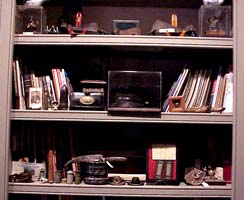 | 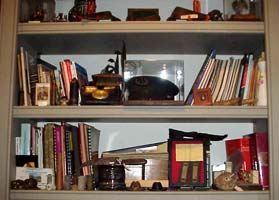 |
Please click on the links or the pictures below for more details and larger picture if available
| #5113 - Displaying Badges in Shadowbox Cases Items that have some 3-D depth such as raised badges or plates might require more room than a simple flat Riker box. In such situations, a "shadow box" frame or display case with an inch or more of depth will suffice. In this picture shown, cap and uniform badges from the Ypres battlefield of World War One lie safely nestled in a custom box with a foam backing. A colored felt could be used as well for contrast depending upon the color or patina of your treasures. If you have enough room to set a display case on a shelf or table, this method of showing relics is great. But if space is limited then hanging a shadowbox frame up upon a wall might work better. However then you must "fix" or mount your items to the backboard to keep them in place. Copper wire mountings set through the backboard are preferred to using any glue techniques which would damage or alter your collectibles. See other pictures in this section which will show you how to safely & correctly wire mount items to vertical backing boards. |  | |
| #5114 - Standing Display Cabinets If you have the space, nothing shows off relics and collectibles better than a freestanding display cabinet that not only shows your items but also serves as a lovely piece of furniture. It can be a focal point to a library, office, den... or simply set off in a corner of any room. There are a variety of such tall glass cases available at furniture stores. Many display from all four sides and have internal lights to accent the pieces you place upon the shelves. Getting one with adjustable heights to the shelves is a big plus. In this picture, we see various fragile and treasured items from three diverse major conflicts: the American Civil War (1961-1865); World War I (1914-1918) and finally World War II (1939-1945). They are clearly housed behind glass in a safe environment where they can be shown with pride to visitors. |  | |
| #5126 - Boxes with Backdrops. There are many unique variations to displaying items in boxes. They can be vintage shadowboxes, newer handcrafted custom box frames, or even standard items bought from popular craft stores. One must strive for not only protection but also "the look" that you want: color of wood, texture, style of frame. The backdrop or back-board can be wood, silk, colored felt, framer's cardboards, or as we see in this case: even a print of the appropriate subject matter. This display has two original dug British cap badges from the World War I battlefields of the Somme superimposed on a print of the British passing through a devastated European town caught in the midst of war. It is an attractive alernative which shows the collector's creativity & enthusiasm for his relics. |  | |
| #5128 - Lucite Stands & Mounts Modern lucite and plastic stands or mounts are great for holding up helmets and cradling relics like shells. They have the advantage of being inert substances without dyes or stains. Also, they are clear to the eye, so they do not "busy up" a display area or block a good view of items to their rear. |  | |
| #5129 - Once upon a Shelf... Klunk!!! Placing relics upon a windowsill or shelf is just fine as long as several things do NOT exist in your environment: 1)small children with long legs, 2)cats with legs, 3) fabrics and documents that might fade in sunlight, or 4) any number of clumsy friends & relatives! Therefore, more "fragile" items are best put behind glass or very high from floor level. OOPS! KLUNK! (Been there, done that...) |  | |
| #5130 - Flat File "Blueprint Drawers" for maps and papers Flat files or "blueprint cabinets" consist of a tier (four to ten) of large flat sliding drawers that are used for prints, papers and other items which need to safely lay out flat. Vintage ones from the 1800's were made of oak as shown in this photograph. In the Twentieth Century they became metal. No matter what their construction, it is best to line the bottom of each sliding drawer with acid-free paper in order to protect your documents from stains, mildew and visiting insects. In fact, it is always wise to check-in upon your prints regularly whether stored in cabinets, tubes, sleeves or carrying cases. If a silverfish gets in for too long and goes to munching the paper fibers, you will be one very sad puppy! Therefore, even when protected in "safe" environments, a collector should inspect his treasures periodically. Vintage-looking oak and pine flat file cabinets are still being made by current craftsmen these days. But they are not cheap. It is best to search-out originals in antique markets and to restore them yourself! |  | |
| #5131 - Vntage Glass Countertop Display Cabinets This type of glass display cabinet isn't made much anymore. They are from the 1860 through 1915 period when grocery stores and department stores displayed valued merchandise in these when placed atop very long counters. Modern antique dealers snap them up for themselves in order to show their goods in consignment malls and shops. But if you can obtain one: Do it! The glass is thick and sturdy, held by thick strips of nickle-plated wood at the edges. The backs slide open or drop down to get at your items. The ratio of glass to wood is huge so there is a lot of pure visual display power to them. Some even come with tiered adjustable shelves inside. And then, gradually, as they gain in height, they become the more common table top display cabinet that was popular for watches and pens in the Victorian times. Adapting old display cases to show your historic artifacts proudly maintains our heritage of solid, sturdy manufacture. |  | |
| #5132 - Any old beveled-glass box.... This fine wooden box was discovered at a flea market. It had odd holes cut in one side as if it held an electrified machine or display piece at one time. The thick beleveled glass on the top shows the items inside nicely. The warm internal wood has a orange sheen to its varnish which promotes the visual impact of the relics within. Why not use antique items with such inherent character to show-off your finer collectibles? And please: Remember to line the insidfe with foam, cloth or felt if your items are either fragile or prone to staining. Unvarnished woods could expose items to their tannins which stain, so seal the wood inside or simply buffer the objects with a layer of something inert. |  | |
| #5133 - Victorian Museum Lidded Box This fine oak table top display box with its custom-fitted lid is a close reproduction to those used in the Victorian-era museum collection of a great American University. In the past, fossils, relics, carvings, animal skulls and larger gems were displayed to the public in this way. Modern cabinetmakers can still create these wonderful wooden boxes. A rare artillery shell, vintage Colt revolver, or a manikin head wearing an original Civil War kepi would look fabulous in one of these stunning containers. And the size could easily be altered to your needs by the woodworking expert who creates it for you. Remember: Seal the inside wood base with varnish or polyurethane to keep tannin wood stains off of your items. |  | |
| #5154 - When Ambrotypes start Flaking Away... If one collects enough Civil War period images, you will no doubt get some "ambrotypes" as well. In that method of preserving images, the emulsion was set and developed directly on a glass plate rather than tin or the later papers. However, the visual image is reversed, so that a backdrop of black colored material is required behind the glass plate to show the image to our eyes. In the Civil War period, a thick syrupy black colloid was painted onto the opposite side (back) of the glass plate. Thus, the image was on one side, while the black paint was put on the other. Over the years, that black paint lifts and flakes away, leaving irregular visual "holes" in the image that we see. And yet, the true emulsion or picture is really still fully intact on the otherside of the plate! By replacing the black paint or filling-in just the flaked off areas, the image appears to be fully intact again! Using a black gloss "model paint" works the best. And yet, it does not damage or alter the original Civil War image (emulsion) on the other side of the plate. Our "new" paint backdrop could easily be scraped off of the glass in the future if one ever wished to use the exact same black colloid-syrup as during the Civil War for some reason. |  | |
| #5162 - A Stunning Photograph with Related Relics If a picture frame gives enough depth, one might consider mounting small flat relics like buttons, insignia or badges upon a photograph or print of the battle from which the items originated. Nothing ties together the place and men with their gear as well as such a demonstrative display. In this particular picture, a collector has mounted badges from World War I upon a print of men charging forth from the trenches. The added section of text further describes and informs us of the surrounding events. As with everything, the more you explain and choose to show, the more vivid the presentation for those wishing to admire & learn. | 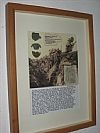 | |
| #5163 - Old Meets New in a Unique Display Board This shows how relics can be displayed in very new & unique ways. These small glass-topped aluminum containers were bought at an antique mall purportedly being from the inventory of an old science department. Maybe they held chemicals, minerals or specimens under their screw tops in the past? In any case, they are now mounted securely down into a walnut display board. This makes for a very interesting look: almost Space Age or Art Deco. And somehow it works for this collection of dug, carved bullets, some of which were used as musket nipple caps by Confederates. |  | |
| #5164 - Custom Button Boxes There are many ways to display buttons. Some are plastic and others more substantial hand-made wooden holders. In this image, we see one of the finer methods for showing and holding vintage buttons: This is a custom button box made by a highly qualified cabinetmaker. There are individual felt-backed cut-outs for each item. The glass top of the hinged-lid shows the whole collection in a dramatic way. When you have rare or better items, you should invest in ways to keep them safe and shown more attractively. Not for sale. |  | |
| #5165 - Pyro-Technics Anyone??? : Adapting Old Boxes Decorating boxes and wall plaques by heat-engraving tools became popular amongst creative ladies caught at home during the Victorian era. The various designs were actually burned-down-into the wood. The glove box shown in this picture is one such vintage piece from an antique mart. And yet, it is a quite practical method of holding historic relics. In this case, snuff boxes and matchsafes from the Nineteenth Century. Also, wooden and cardboard cigar boxes are excellent choices for holding small groups of items, such as bullets, buttons or insignia. |  | |
| #5188 - UNIQUE DISPLAY FOR A DEAD COMRAD This is a most unique "display" that was created in 1908 as a memorial for a deceased comrad. When Comm. Michael Reilly died an acquaintance of his wrote some facts down about his Civil War service and his military burial upon a piece of paper. The paper was then carefully rolled up and slid down into a brass rifle casing. There is also a spiral of facts pasted to the outside of the casing! Then, it all was wrapped in tissue paper with a red ribbon. And, almost 100 years later, this unusual "display" of a brass bullet casing has kept the information about a Civil War Naval Veteran safe through time! |  | |
| #5189 - Once wood and iron becomes iron on wood... These relics from Civil War battlegrounds were housed for many years in an old private roadside museum collection in Ohio. But when it closed, they were auctioned off... left rattling around in a small cardboard box! But with some small nails and copper wire, they are now mounted upon an old oak board from an abandoned garage in New Jersey! We see that some basic labels, wood stain and proper "spacing" of items makes this a really attractive relic board with a super "old look." Like anything else in life, when it comes to showing your relics, you need to work with what you've got! | 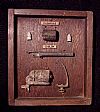 | |
| #5515 - Custom Made: Tiered Bullet Display Case This custom built hard-wood display case was designed to show off bullets along its four inner tiers. Based upon my design, it was hand-crafted by a master cabinetmaker. Its top is hinged. The sides of the cover have glass panes for viewing the contents. It is solid, heavy and a beautifully unique display item for the extremely discriminating Civil War enthusiast. Not for sale. |  | |
| #6099 - Fantastic Early Gettysburg Relic Desk Set Relics from battlefields have been collected and sold to veterans and history buffs since just after the Civil War ended. Many GAR and UCV Veteran Reunions of the late Nineteeth and Early Twentieth Century saw thousands of old soldiers and their families returning to sites of youthful battles. Many wanted souvenirs. And local businessmen supplied them. As the vets died off, their children and finally modern history buffs still sought such items. Desk sets have always been popular. In the "early days" it was not difficult to still get plates and Confederate buttons for such sets. In fact, they simply nailed the items down to a wooden base! We would be more careful now... This great desk set of relics from the Gettysburg Battlefield was likely assembled and sold to the tourist trade in the early part of the Twentieth Century. Not only does it have shell fragments and a Union soldier's "US" beltplate, but a rare Confederate "droop wing" eagle button. NOT FOR SALE. |  | |
| #6734 - Old Gettysburg Relic Souvenir Desk Set A matter of interest. Soldiers and their relatives returned to Gettysburg Battlefield for almost sixty years afterward. Many wanted war relics from the site as momentos. Local businesses sold desk sets to them like these wooden bases shown. There were often small solid grape shot, buttons and bullets included. On bigger sets, a buckle of brass kepi insignia were added. Depending upon their size, complexity and labeling, these old relic displays command a price in the low- to high-hundreds of dollars now. |  | |
| #6870 - Shopping Days end with a Treasure Chest Of course, you get your purchases home and they can NOT stay in a carton box! Now the fun task of sitting on the floor and sorting it... and putting things in envelopes, film cannisters, frames, and upon the shelves! |  | |
| #8971 - World War I Fighting Blades Recessed in Foam These two relics from World War I battlefields are nestled in foam pad that was carefully cut-out to fit their outer shapes. This way, they are safer and look nicer than just laying around loose on a desk or shelf. |  | |
| #10896 - US Belt Plate Mobile Bay on Old Relic Shield This is cool: an old wooden relic shield from Bannerman's Military Supply. It has Indian War era artillery kepi buttons and 2 brass infantry hunting horns. Also mounted to this old wood board is the dug skin of an original US Belt Plate from the Civil War, found at Battle of Mobile Bay. The digger's site tag is mounted on face of board as well. This is a cool item for the wall of an office! | 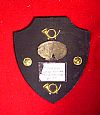 | |
| #11454 - Good Cleaning and a Riker Case Sometimes, too much cleaning is bad. You don't want to polish a genuine dug brass plate to a bright shine that glares and looks fake. But sometimes, too little cleaning can obscure details and dirt is not attractive either! After cleaning this US Beltplate just the right amount with warm water and a toothbrush, it was thoroughly dried. Putting it in an inexpensive "Riker case" ontop red felt backing certainly gives it a more impressive look for display. |  | |
| #12620 - Using fancy Old Frames to Display Photographs During the Civil War period, images were kept either in small cases or albums. There were very few wall frames for images. Later, as the Veterans aged and bought big Victorian houses, they wanted to proudly display their war service images. Photographs were retro-fitted into fancy frames for their parlors, libraries and hallways. Using old frames to house CW images can be great, as long as you don't damage them with mats, glue, adhesives. Light can also fade old images, so hang them in a darker section of your home. This image is a CDV of an officer with his wife now housed in an ornate Victorian Eastlake Style shadowbox frame. | 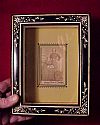 | |
| #15609 - Display of Relics upon an Original Officers Desk This is a excellent display of Civil War relics placed upon an original compartmental officer's desk. The display method is quite "museum-like" in its spacing and mixture of these related historic items. Not only are planning and care evident, but also an obvious guiding passion for their intertwined history. Photo was donated for Cyber Museum viewing by an enthusiastic CW enthusiast. Extra points Quiz: See how many items you can name and describe! | 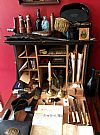 | |
| #16001 - Antique Glass Top Tables Victorians were amazing collectors. And they KNEW how to create attractive, interesting displays at old-type museums. Places were dark, maybe scary, but totally "chocked full" of treasures. Well, those Victorian took-it-home to their dens, parlors, and libraries! A prime example is the glass-topped table. Still found at antiques stores. They can be co-opted to display your Civil War relics which tend to be flat, like medals, pamphlets & ribbons. A colored piece of backing felt makes it pop! The color depends on your decorative style, mood, or whether you are a Yank or a Reb! |  | |
| #16002 - Minies Relic Board from Colonel Vietzen Museum When I first started buying Civil War items, I had the luck to attend the auction of the Colonel Vietzen Civil War & Native American Museum in Ohio. It was active for decades, but now, being dissolved after his death. I was a wide-eyed kid in a candy store. While many fine & expensive relics changed hands, I was most interested in the common relics with a historic "feel" and seeming story. Thus, I bought this plain felt-lined wooden tray of common impacted Civil War minie bullets. It reminded me so much of the displays in old museums that I gazed at in awe as a child. Things do not need to be large, fancy, or expensive to be valuable to the imagination. |  | |
| #16102 - Civil War Relics mounted on Old Barn Tray Old wooden seed trays from cellars and barns are excellent for mounting three dimensional relics. In this case, three parts of a Civil War revolver dug at Vicksburg, MS. The relics can be supported with thin copper wire through openings or exterior wire-wrapping. The wires then supported by copper nails. A custom painted label on wood for the location of the recovery is always nice. Then, hand on a wall using screw eyes and framing wire on back. Neat look that works! | 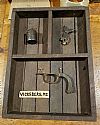 | |
| #16734 - Relics from Gettysburg Battlefield of 1863 in cigar box These are field pickup relics from the 1863 Battle of Gettysburg. Possibly collected by a returning Vet who strolled hills and fields where he once fought and friends died. Relic hunting occurred almost immediately after the battle ended by local citizens. Soon, local entrepreneurs collected relics to sell in shops to droves of tourists. In Twentieth Century, the fields were mostly clear of objects. After World War 2, modified mine sweepers were used to hunt underground metal items. But the practice was forbidden on National Park areas in Seventies. Most relics surface these days as old collectibles and relic sets like this one. The label is of the 1900-1945 era. The relics in this old cigar box are from a span of time, the darker bullets immediately after the conflict, and corroded items from later decades. A nice mix, attractively presented. |  | |
| #16785 - Amazing Slouch Hat with variety of Vintage insignia This a a genuine vintage UCV era (1880`s-90`s) tan material slouch hat which was custom accessorized by an avid history-buff/collector. The robust ostrich plume is a Civil War era relic. The palmetto insignia is once again an original UCV era device. The embroidered crossed sabers from CW to IW era. This is an excellent "marriage" of relic devices with a vintage slouch hat. It displays with a regal aplomb! |  | |
| #16787 - The Grave Markers of Soldiers of various Wars I was strolling the Tunnel Hill Cemetery in Elizabethtown, PA. reading the stories of past lives. Cemeteries are quiet places honoring our past generations. I recommend going there to reevaluate your values as an American and to simply get your head & heart readjusted. In any case, I decided to find the graves of veterans from all our recent wars. I show these photos of the grave markers I observed. None from the desert wars in this older cemetery. |  | |